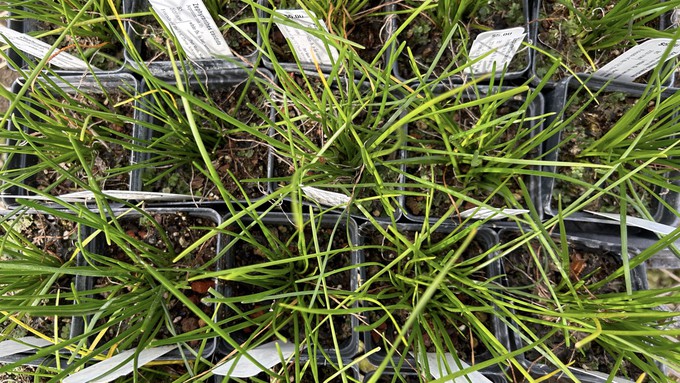
Find bargain prices on 11,000 water-wise perennials, shrubs, trees, succulents, natives and more

An estimated 34 3-inch pots of Argentine rain lilies (Zephyranthes candida) will be on sale during the UC Davis Arboretum clearance Saturday, according to the inventory list. The plants bring bright white flowers to semi-shady areas during summer. Kathy Morrison
Here’s your last chance to get great bargains on water-wise plants – at least for this spring.
On Saturday, May 11, the UC Davis Arboretum Teaching Nursery is hosting its final plant sale of the season and it’s a big one – the annual Spring Clearance Sale. The nursery still has about 11,000 beautiful plants that need new homes.
Think you’ve seen all they have? Think again; almost 70 new plant varieties have been added since the nursery’s first sales in March and April.
From 9 a.m. to 1 p.m., everything is on sale. This event is open to everyone the whole four hours; admission is free.
All plants are priced to sell: 20% off. Friends of the Arboretum get 30% off. Not a Friend? Join at the gate and get the discount plus a $10 coupon as a free gift.
The 1-acre nursery specializes in water-wise flowering perennials, ground covers and shrubs. Also find an excellent selection of succulents and scores of California natives.
To see the updated inventory and photos in advance, go to: https://arboretum.ucdavis.edu/plant-sales.
The nursery asks shoppers to bring their own boxes, if possible, to take home their new plants. If you have your own wagon or cart, that’s helpful to bring, too.
The Arboretum Teaching Nursery is located on Garrod Drive opposite the Veterinary Medicine complex and small animal hospital on the UC Davis campus.
Besides hosting the plant sale, the nursery is also home to beautiful demonstration gardens showcasing the Arboretum All-Stars and other water-wise collections.
For directions and more: https://arboretum.ucdavis.edu.
Comments
0 comments have been posted.Sacramento Digs Gardening to your inbox.
Sites We Like
Garden Checklist for week of July 21
Your garden needs you!
* Keep your vegetable garden watered, mulched and weeded. Water before 8 a.m. to reduce the chance of fungal infection and to conserve moisture.
* Feed vegetable plants bone meal, rock phosphate or other fertilizers high in phosphate to stimulate more blooms and fruiting. (But wait until daily high temperatures drop out of the 100s.)
* Don’t let tomatoes wilt or dry out completely. Give tomatoes a deep watering two to three times a week.
* Harvest vegetables promptly to encourage plants to produce more. Squash especially tends to grow rapidly in hot weather. Keep an eye on zucchini.
* Pinch back chrysanthemums for bushy plants and more flowers in September.
* Remove spent flowers from roses, daylilies and other bloomers as they finish flowering.
* Pinch off blooms from basil so the plant will grow more leaves.
* Cut back lavender after flowering to promote a second bloom.
* It's not too late to add a splash of color. Plant petunias, snapdragons, zinnias and marigolds.
* From seed, plant corn, pumpkins, radishes, winter squash and sunflowers.